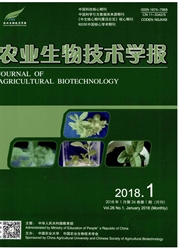

 中文摘要:
中文摘要:
原始生殖细胞(primordial germcells,PGCs)是生殖母细胞的前体细胞,作为一种多能干细胞,具有与胚胎干细胞相似的形态及分化潜能,能在体外进行培养、传代,并在一定条件下保持未分化状态及多能性。现阶段PGCs的体外培养体系中往往存在饲养层细胞和血清,为后期研究造成了困难和混淆。为建立粤黄鸡(Gallus galluslPGCs的体外无饲养层培养体系。本研究通过改进培养体系成分分离纯化PGCs并进行体外培养。结果显示,所得无饲养层培养的PGCs直径为6-8儿m,生长曲线呈现“S”形,群体倍增时间(3.75±0.151d,结果表明,PGCs具有良好的增殖生长状态;对分离纯化的PGCs特异性基因胚胎阶段特异性表面抗原(stage specific embryonic antigen.1,SSEA—J)和类无精症缺失基因(deleted in azoospermia—like,DAZL)进行免疫荧光鉴定,结果显示二者在PGCs均有表达,经化学免疫染色的细胞可观察到绿色的荧光;将无饲养层培养的PGCs用PKH26标记,注射到孵化至17~20期受体鸡胚的背主动脉中,继续孵化至第5.5天,结果显示,分离纯化并通过PKH26标记的鸡胚血液PGCs仍然具有PGCs的特性,可随鸡胚的血液循环定殖于鸡胚性腺中。本研究优化了PGCs体外培养的条件,建立无饲养层无血清培养体系,为家禽PGCs应用于现代保种技术、转基因技术以及家禽的发育生物学等研究领域提供了重要的技术支持。
 英文摘要:
英文摘要:
Primordial germ cells (PGCs) are precursor cells of gonocyte, as a kind of pluripotent stem cell, PGCs have a similar morphology and multilineage potential with the embryonic stem (ES) cell. It can be cultured and subcultered in vitro and maintain its undifferentiated state and pluripotency under certain conditions. At present, PGCs are often cultured with feeder cells and serum, which causes difficulties and confusion for the later research. In order to establish a feeder-free culture system for PGCs in poultry, PGCs were isolated and cultured in vitro by improving the culture system in this study. The results showed that the PGCs with no feeder layer were 6-8 μm in diameter and the growth curve showed "S" shape. The population doubling time was (3.75±0.15) d. In the course of in vitro culture, PGCs could have better self-renewal and proliferation in the absence of feeder layer system conditions. PGCs could be cultured in vitro and maintain their undifferentiated state. Compared with similar studies this study not only maintained PGCs differentiation potential, but also obtained a large number of cells. The absence of feeder layer system could make PGCs maintain good growth status and had strong cell viability. The specific genes stage-specific embryonic antigen- 1 (SSEA-1) and deleted in azoospermia-like (DAZL) of PGCs were identified by immunofluorescence, and the results showed that both of them were expressed in PGCs, the cells stained by chemical immunization could observe the green fluorescence. The purified PGCs were labeled with PKH26 and cultured by feeder-free layer, then they were injected into the dorsal aorta of recipient chicken embryo that was hatched to the 17-20 stage until 5.5 d. The results showed that the PGCs which were isolated from chicken embryo had the same characteristics of itself after PKH26 labeling, which could be colonized in chicken embryo gonads with the blood circulation of chicken embryo. PGCs in vitro culture system had been optimized to ensure the u
 同期刊论文项目
同期刊论文项目
 同项目期刊论文
同项目期刊论文
 期刊信息
期刊信息
